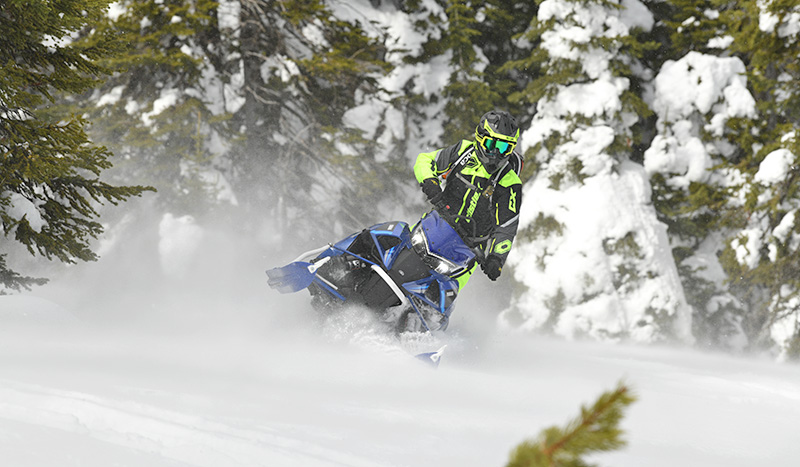EDITORS NOTE: For the 2014-15 season, Snow Goer magazine has added a new element to each issue called “Snowmobile Science.” Authored by trained engineer and mega snowmobile enthusiast T.J. Krob, Snowmobile Science takes readers behind the scenes for a scientific look at the sport of snowmobiling. In the October 2014 issue, Krob penned the following column. To see all of Krob’s work on a regular basis, subscribe to Snow Goer by clicking here.
Buy The Right Fuel
The Science Behind Octane, Ethanol & Gas Burning Engines
Fuel is the lifeblood of your snowmobile engine. Sometimes we obtain this mysterious fluidic mixture straight from a metal nozzle at the corner gas station, or other times we pump it from a barrel with fancy symbols and words on it. In either case, we love the feel and the aroma of burning that fuel to make tracks in the winter, but how does it all work? There are plenty of things to ponder when you pull up to a pump with your snowmobile. Will you buy the right fuel?
What Is Octane?
To prevent degradation and eventually abrupt failure of the powerplant, engine knock is a condition that must be avoided when zipping around on sleds.

The chemical composition of pure gasoline is a mixture of hydrocarbons having five to 12 links, such as C8H18 (Iso-octane). The combination of various types or quantities of hydrocarbon isomers (Heptane, Pentane, Hexane, etc.) or even lead gives a fuel its octane rating. On most performance engines, snowmobile manufacturers suggest burning 91 octane, premium unleaded fuel – and “91” has a distinct meaning behind it. Octane is a descriptor used to identify the anti-knock index (AKI).
Knock or ping noises stem from fuel with too low of an AKI burning uncontrollably and displaying multiple flame fronts inside a cylinder after the spark plug fires. Knocking will occur if the air/fuel mixture reaches an auto-ignition point (also known as detonation) on the heels of rising cylinder pressures. Conversely, fuel ignition can happen before the spark plug fires due to excessive heat igniting the fuel in the cylinder, usually caused by faulty mechanical setup or a lean air-to-fuel mixture, not the octane of the fuel. This is called pre-ignition.
In a case of auto-ignition: As the piston rotates toward top-dead-center of the stroke, thermodynamic law kicks in stating that as the fuel and air mixture is compressed within a decreasing volume, its temperature increases. Increasing the temperature too much can reach the auto-ignition point of the fuel. High octane fuel has a higher auto-ignition temperature, thus directly relating the AKI and the prevention of auto-ignition or detonation.
Engines equipped with knock/detonation sensors sense vibration that happens when an engine knocks and retards the spark timing to prevent engine damage, but that comes at the expense of producing less power. Of course, riders want the most power possible out of engines, and we want to keep the knock sensor from pulling timing so we can enjoy this power. That must mean that engines need the highest octane possible, right? Not quite.
Burning fuel with an octane rating that’s too high can actually decrease power output, and it’s more evident at higher elevations. As elevation increases, the density of the atmosphere decreases so there’s less air for engines to pump.
Once again those pesky thermodynamic laws kick in, telling us that this lower air pressure will also pull down the burn temperature of the combustion event, resulting in less horsepower. If octane is increased to control the onset of knock without actually needing more octane to sustain a controlled burn, the burn of the fuel becomes incomplete and no extra energy is extracted to make more horsepower. An engine calibrated for maximum power would have the fuel burn at the quickest rate possible – just short of producing a knock. Only by optimizing the internal engine components to pair with the chosen fuel can more power be squeezed from higher-octane fuel.
Snowmobilers experienced with riding in the mountains and the flatlands know that sleds are more powerful at low elevation. Manufacturers of engines that rely on a specific octane publish this information to prevent detonation at the location where the most power is produced – sea level. As this machine is brought to higher elevation, lower octane fuels such as 87 may be adequate to prevent knock, and the engine could produce slightly better throttle response since the fuel is burning fast enough without leaving leftover energy on the table.

A snowmobile manufacturer’s specification for octane describes the best fuel to burn inside the engine when the internal geometry such as bore, stroke and compression ratio are taken into account. High-energy fuels have only small amounts of gasoline contained within them and their chemical composition is perfect for high horsepower applications. Race fuel manufacturers insert additives that act as oxygenators – like nitrous – thus supercharging each fuel burn. These engines consume more fuel per revolution than typical snowmobile engines. The chemical composition of the fuel is tailored to suit this high-performance application so the combustion event is optimized on the edge of preventing knock while still extracting the most energy possible.
Renewable Fuels
Ethanol (ethyl alcohol) popping up at gas stations across the country is an Environmental Protection Agency mandate of a renewable resource extracted from crops such as corn. This colorless liquid is designed to eliminate some of the hydrocarbons burned when using pure gasoline. Altering the chemical composition of fuels in vehicles has a drastic effect on how an engine cylinder extracts energy. The good news is that pure ethanol has an AKI of almost 100. But (there’s always a but) octane is not the only player that affects how an engine runs, and instead, the amount of energy available from a fuel is most important.
One gallon of gasoline contains 114,100 BTUs, while ethanol only contains 76,100 BTUs. While pure ethanol is never something that could be poured into the fuel tank of a snowmobile, there are cases where a blend of more than 10 percent ethanol is sold at pumps. Even for just a 10-percent blend with gasoline, the natural oxygen presence in ethanol alters the chemical composition, which affects how much fuel the engine needs and how the fuel burns during the combustion event. Oxygen in ethanol effectively increases the gasoline requirement by more than 4 percent to maintain a safe and powerful burn in the cylinders – 14.7 parts of air to 1 part of pure gasoline, compared to 14.1 parts of air to 1 part of E10. The higher the ethanol content, the higher the volume of fuel must be injected.
Noteworthy is that fuel-injected highway vehicles equipped with exhaust sensors monitor this burnt exhaust ratio and will automatically increase the amount of fuel that is injected. Thus, a vehicle running pure gasoline will get better fuel economy than a vehicle burning fuel with ethanol. For snowmobiles that do not contain exhaust sniffers, owners must take care when fueling with any amount of ethanol to avoid engine damage as not all machines are supplied with automatic fuel delivery modifiers. Most fuel-injected snowmobiles built in recent years are programmed rich enough to compensate for a 10 percent blend or can be manually switched between two maps to correlate for the fuel the engine receives. Higher concentrations of ethanol, though, are problematic.
Moving to the automotive world, we all know someone who says, “This truck has never seen anything but premium fuel in her!” Of course, that guy thinks he’s babying the engine and getting the most performance out of it, but this line of thinking, just like with snowmobile engines, is incorrect. Over-buying fuel just to get increased octane does not benefit an engine in any way. Instead, over-buying fuel to steer clear of ethanol is a better reason.





That’s a good point that ethanol only contains 76,100 BTUs. But at least it’s a better option for the environment. It’s important to take your concerns as part of your fuel purchasing decision.